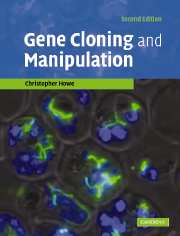Book contents
- Frontmatter
- Contents
- Preface to first edition
- Preface to second edition
- Chapter 1 The tools for the job
- Chapter 2 Polymerase chain reaction
- Chapter 3 Simple cloning
- Chapter 4 Other vector systems for E. coli
- Chapter 5 Making libraries
- Chapter 6 Screening libraries
- Chapter 7 Modification and mutagenesis
- Chapter 8 Use of cloned DNA
- Chapter 9 Using other organisms
- Chapter 10 Examples
- References
- Index
Chapter 5 - Making libraries
Published online by Cambridge University Press: 05 June 2012
- Frontmatter
- Contents
- Preface to first edition
- Preface to second edition
- Chapter 1 The tools for the job
- Chapter 2 Polymerase chain reaction
- Chapter 3 Simple cloning
- Chapter 4 Other vector systems for E. coli
- Chapter 5 Making libraries
- Chapter 6 Screening libraries
- Chapter 7 Modification and mutagenesis
- Chapter 8 Use of cloned DNA
- Chapter 9 Using other organisms
- Chapter 10 Examples
- References
- Index
Summary
Introduction
We encountered the concept of a library, a collection of random DNA clones, in Chapter 3. Having learned about cloning in bacteriophage viruses and their derivatives in Chapter 4, we are now in a position to look in more detail at making libraries.
Libraries can conveniently be divided into two categories: genomic libraries, which are made from the total genomic DNA of an organism, and cDNA libraries, which are made from DNA copies of its RNA sequences. We will look first at how these two types of library are made. Sometimes, though, it is useful to be able to make a more specialized genomic or cDNA library, enriched for particular sequences, so we will look at how they are made too. The library we looked at in Chapter 3 was a plasmid genomic library. It was represented by a large number of colonies on a plate, each containing a plasmid with a defined insert. We can also use a phage vector; handling large numbers of phages is often more convenient than handling large numbers of plasmids. When using phage, we get a collection of plaques on a lawn of bacterial cells, rather than colonies. Each plaque will contain a single type of phage with a defined DNA insert. With cosmids, fosmids, BACs and PACs, replicating as plasmids, the library will again be colonies on a plate.
- Type
- Chapter
- Information
- Gene Cloning and Manipulation , pp. 98 - 115Publisher: Cambridge University PressPrint publication year: 2007



